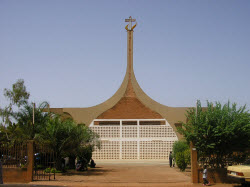Burkina Faso Country Information
Background
Burkina Faso, or Burkina to the locals is greographically located in the heart of West Africa. President Thomas Sankara renamed it on August 4, 1984 to mean "the land of upright people." However, prior to that the world knew Burkina Faso originally by the Republic of Upper Volta. Burkina Faso remains an alien place to most of the developed world, but once you set foot in this country it will blow your imagination away. Burkina Faso is composed to two types of landscapes. The majority of the country is blanketed with gentle undulating hills and plains. In the southwestern areas you will find a sandstone peak called Ténakourou. The reason this country was called Upper Volta was because there are three rivers that flow across the country named Black Volta, White Volta, and Red Volta. This country is filled with natural attractions to visit and not only that is a cultural mixture of different people that include Burkinabé and other ethnic groups.
This country does have a good portion of its citizens living below the poverty line, but that does not hold it back for being one of the more stable countries in the region and it encourages travelers to come visit and experience the people and cultural richness of the country. There are always things to do here in Burkina Faso. It holds a yearly film festival in the the capital city of Ouagadougou called FESPACO (Festival Panafrican du Cinéma et de la Télévison de Ouagadougou). You can also visit the Grand Mosque in the older and smaller town of Bobo-Dioulasso. You can also partake in a few wildlife safaris in the southern area. Why wait until later if you can come to Burkina Faso and leave with memories that will last you a lifetime. |
Geography
|
- Area: 274,200 sq km (105,869.212 sq mi)
- Terrain: Mostly flat; hills in the western and southeastern sections.
- Climate: hot & humid in the summers, and winters are dry and warm
|
People
|
Burkina Faso's population includes the major ethnic group called Voltaic Mossi and the groups are called Gurunsi, Senufo, Lobi, Bobo, Mande, and Fulani. These ethnic groups live in the south and center of the country. Due to a lack of jobs you will find that a lot of Burkinabe will head over to Cote d'Ivoire and Ghana to look for agricultural work.
|
Government
|
Burkina Faso ratified its constitution in June 2, 1991. It would form a parliamentary republic. It has an executive branch, legislative branch, and judicial branch. The executive branch has the President, the Prime Minister, and Council of Ministers. The elected president will serve the country for five years. The president will appoint the Prime Minister with an agreement from the Legislative Branch. The Council of Ministers is appointed by the president with recommendations made from the Prime Minister. The Legislative Branch has 111 seats and are won by popular vote. Elected officials will serve for five years. In the Judicial Branch Burkina Faso has both and Appeals Court. There are a couple political parties in the government that incldue African Democratic Rally-Alliance for Democracy and Federation (ADF-RDA), Citizen's Popular Rally (RPC), Coalition of Democratic Forces of Burkina (CFD-B), Congress for Democracy and Progress (CDP), Democratic and Popular Rally (RDP), Movement for Tolerance and Progress (MTP), Party for African Independence (PAI), and several others.
|
| |

|
